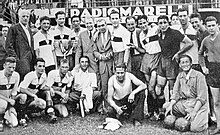History of Genoa CFC

The club was founded on 7 September 1893
|
|
|
On 10 April
Historical outline
Championship dominance

Football in Italy stepped up a level with the creation of the
Genoa returned for the
The club strip was changed again in
Notably Genoa became the first Italian football team to play an international match, when they visited France on 27 April 1903 to play
The fall in part during this period can be traced back to
Garbutt revival
With the introduction of the
Finally by

Just after the war, Genoa remained a strong contender in the Northern section.
The squad during these two championship victories included;
Genova 1893 period
Due to the strongly British connotations attached to the name, Genoa were forced to change it by the

The club's league form became highly erratic during the early 1930s, with varying league positions; it was during the
During the
World War II affected dramatically the entire Italian football movement, but Genova did not recover as well as other clubs. In 1945, the club chose to revert their name to Genoa Cricket and Football Club, the one which they had used in the very early days of the Italian championship.
Post-war period

After the Second World War the ability of Genoa to finish in the upper ranks of
Despite suffering a relegation in
The celebrations for the club did not last long however, as the year following their last cup success they were relegated down to Serie B again. This time their stay at the second tier of the
Mixed times
Throughout the 1970s, Genoa would play the role of a

The relegation was bad for the club in more ways than one, they lost some of their top players who could have offered them a swift return; such as Roberto Pruzzo's move to
Still with Simoni at the helm as manager, Genoa were able to survive in Serie A for their returning season, they finished just one point ahead of the relegated AC Milan, it was a dramatic last day of the season as Genoa were trailing 2–1 to
European experience
The club was purchased by
Subsequently, the club gained entry to the
During the
Recent times
After the take-over in 2003, things started to look up for Genoa; they won
For their season in Serie C1 for
In the recent 2008-2009 championship Genoa started out with a defeat in the sicilian away match with Catania but was then graced with the comeback of Argentinian forward Diego Milito a talent which played with Genoa in second division and was then sold after the team had been relegated to third division despite finishing at the division's top due to an alleged combine.
Milito was glad to come back to Genoa and play in Italy's Serie A and greatly contributed to a very successful season which saw the red and blue genoese griffins finishing fifth and securing a UEFA placement, while winning both derbies against the striped
References
- ^ a b c d e f g h i "Genoa Cricket & Football Club - Short Historical Overview 1893-1960". RSSSF.com. Retrieved September 1, 2007.
- ^ a b "1893 VS. 1897 Le Origini (a cura di Aldo Padovano)". genoacfc.it. Archived from the original on 2015-06-27. Retrieved May 7, 2013.
- ^ a b c "Storia del Genoa - Part 1". EnciclopediaDelCalcio.com. Archived from the original on 2016-02-01. Retrieved September 1, 2007.
- ^ "Edoardo Bosio and Football in Turin". Life in Italy. Retrieved September 1, 2007.
- ^ a b c d e f g h i j k l Modena, Panini Edizioni (2005). Almanacco Illustrato del Calcio - La Storia 1898-2004.
- ^ "Genoa All-Time XI". Channel4.com. Retrieved September 1, 2007.
- ^ "Club Profiles - Genoa". Forza Azzurri. Retrieved September 1, 2007.
- ^ a b c d "Il Genoa leggendario". La storia del Genoa. Archived from the original on 2007-08-13. Retrieved September 1, 2007.
- ^ a b "Campionato Serie A - Albo D'oro". Lega Calcio. Archived from the original on 2007-08-24. Retrieved September 1, 2007.
- ^ "Levratto - Profile". Encilopedia Del Calcio. Archived from the original on 2007-09-27. Retrieved September 1, 2007.
- ^ "Storia del Genoa - Part 4". EnciclopediaDelCalcio.com. Archived from the original on 2007-08-19. Retrieved September 1, 2007.
- ^ "Italy - Coppa Italia History". RSSSF.com. Retrieved September 1, 2007.
- ^ "Genoa - Contributions to the Italian national team". Forza Azzurri. Retrieved September 1, 2007.
- ^ "Genoa". Weltfussballarchiv. Archived from the original on 2007-10-25. Retrieved September 1, 2007.
- ^ a b "Mister Genoani". Genoa1983.org. 27 August 2007. Archived from the original on 10 May 2007.
- ^ "Italy 1948–49". RSSSF.com. Retrieved September 1, 2007.
- ^ a b c d "I campionati". GenoaDomani.it. Retrieved September 1, 2007.
- ^ "Cup of the Alps 1962". RSSSF.com. Retrieved September 1, 2007.
- ^ "Cup of the Alps 1964". RSSSF.com. Retrieved September 1, 2007.
- ^ a b "Presidenti Genoa". Genoa 1893. 23 June 2007. Archived from the original on 20 May 2007.
- ^ "Italy Championship 1977-78". RSSSF.com. Retrieved September 1, 2007.
- ^ "Roberto "Bomber" Pruzzo". ASR Talenti. Retrieved September 1, 2007.
- ^ "Totonero: Le foot italien retient son souffle". LexPress.fr. Archived from the original on 2008-10-08. Retrieved September 1, 2007.
- ^ "Genoa - Napoli". FootballData.it. Archived from the original on 2008-02-16. Retrieved September 1, 2007.
- ^ "Italy Championship 1983-84". RSSSF.com. Retrieved September 1, 2007.
- ^ "Italy Championship 1990-91". RSSSF.com. Retrieved September 1, 2007.
- ^ "The XI at 11: Liverpool home defeats in Europe". Setanta.com. Archived from the original on 2008-05-14. Retrieved September 1, 2007.
- ^ "Storia del Genoa: 1986 - 1995". MaggioAntonio.it. Archived from the original on 2008-02-18. Retrieved September 1, 2007.
- ^ "Anglo-Italian Cup 1995-96". RSSSF.com. Retrieved September 1, 2007.
- ^ "Genoa demoted after match-fixing". BBC.co.uk. 28 July 2005. Retrieved September 1, 2007.
- ^ "Serie B - Playoff no, playout sì". Eurosport. 24 June 2007.
